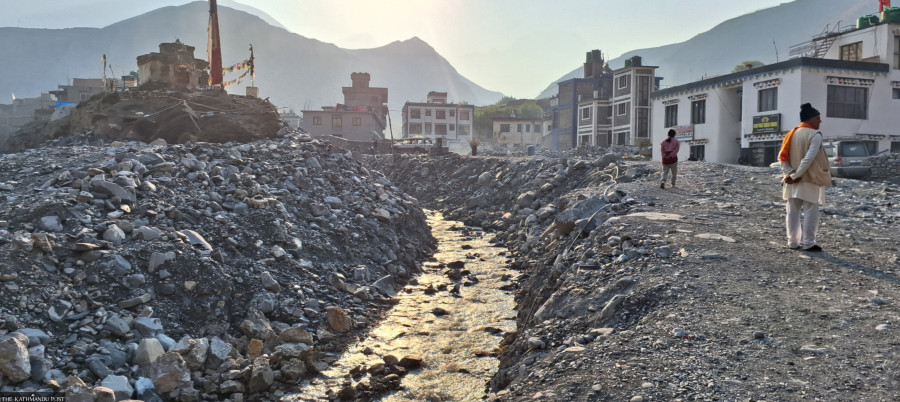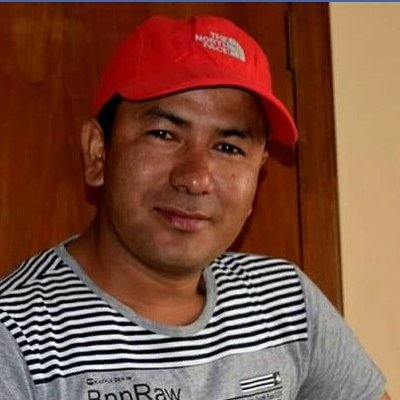Gandaki Province
Kagbeni residents fear monsoon havoc amid government inaction after last year’s flooding
Local units cannot prepare for disaster management as it requires huge funds and expertise, so provincial and central governments must take measures to reduce the risk, says expert.
Basant Pratap Singh
Dawa Dorje of Kagbeni, Mustang, is busy repairing his two-storey house ravaged by last August’s flood. It takes months for Dawa to clear the sand and pebbles, fix the damaged house and make it habitable again.
“I have spent around Rs4 million to clear the sand, pebbles and stones and to furnish the ground floor of my house. I managed to clean up the first floor, but could not furnish it due to lack of money,” said Dorje, a hotelier. It will take more time to make the first floor habitable, he complained.
It had been just a month that Dorje started a hotel in his new house when the deluge in the Kagkhola damaged the building on August 13, 2023. The floods entered the house that he built at the cost of around Rs30 million. The flood did not wash away the house due to its strong foundation and structure. But the flood accompanied by mud and stones shattered the doors and windows and wreaked havoc on the new building. All the property and furniture in both the floors were destroyed.
“The house was almost buried by the mud, sand and stones. It took me months to clear the debris and restore it to its current condition,” said Dorje.
The Dorje family started living in the house but they are still worried, fearing future floods. “It has not rained in the area lately, but the rainy season is coming. I don’t know what will happen to us in the monsoon,” said Dawa. His house, which is just 15 metres from the Kagbeni stream, is at high risk of flooding if the stream surges like last year.
The massive flood damaged dozens of houses in Kagbeni, a revered pilgrimage site for Hindus and Buddhists situated at ward 4 of Baragung Muktikshetra Rural Municipality, displacing 35 families. The flood swept away a motorable bridge, three wooden bridges, and a suspension bridge in the area. Several structures including the police post, schools, ward office, temple, gumba (monastery) and a resting place, and also damaged. Electricity poles and the drinking water project also suffered damage.
The natural disaster occurred after a landslide above Kagbeni obstructed the Kagkhola stream. The blocked stream eventually burst and wreaked havoc in the settlements downstream.
The Kagkhola stream flows between two settlements in Kagbeni. It has been more than nine months since the disaster, but the authorities concerned have not taken any concrete initiative to mitigate future flooding in the area. Dorje and other house owners have been repairing their ravaged houses on their own.
“All 13 rooms on the ground floor were completely damaged. The floods also damaged four other rooms upstairs. Property worth around Rs5 million was destroyed in the floods,” lamented Dawa Thapa, another flood victim. He owns Hotel Karnali in Kagbeni. “I invested Rs29 million to start the hotel. But merely seven months into operation, the floods damaged it,” he added.
Thapa said that he had no choice but to repair the hotel since he had invested millions of rupees in it. He fears that future floods will cause further damage in the area. “The stream flowed at a lower level before last year’s flooding. But siltation has raised the river bed. Even with less water volume than the previous year, the river will cause more damage due to the elevated riverbed,” asserted Thapa.
Nepali expats from Mustang and other districts have collected funds and restored the road, which was damaged by the flood. They have cleared the flood debris and repaired the river bank. Despite these efforts, the flood threat remains until a safe embankment is built and locals complain that the government has taken no measures to control flooding.
Yungduk Gurung, from Kagbeni, has a family of eight and is living in a small house with two small rooms after his house, land, and property were completely washed away by the flood.
“Those who lost everything after the flood swept away their homes haven’t been able to rebuild their lives, and the government has not fulfilled its promise of rehabilitation. My family has not eaten or slept properly for eight months now,” said Gurung. "Initially, we were told that a new settlement would be built for the displaced and we would be relocated there, but due to the negligence of the government, the work on the settlement has not progressed,” Gurung added.
After the flood, the then Deputy Prime Minister and Home Minister Narayan Kaji Shrestha, the then Chief Minister of Gandaki Province, and other high-ranking officials reached Mustang and promised that relief and reconstruction efforts would be accelerated and rehabilitation would take no time.
Prime Minister Pushpa Kamal Dahal, who visited the disaster area in mid-October, three months after the flood, also said that he has taken the Kagbeni flooding very seriously and announced to arrange Rs500 million through donor agencies for rehabilitation and purchase of relief materials.
The residents of Kagbeni fear a repeat of the tragedy as safety measures including building a new embankment announced by the government have been implemented.
“Ministers and leaders come, give speeches, make commitments and promises, but fail to deliver, leaving the poor victims deceived. No preventive measures have been taken, due to which more than 50 houses and hotels, a school in Dobhan, and other places along the Kagkhola are at high risk of flooding,” said Karma Dhyacho Gurung, ward chair of ward 4 of Baragung Muktikshetra Rural Municipality. “Currently, the Kagkhola has changed its course in several places, and it is uncertain where it will flow if the water level rises. If another flood occurs, people will have difficulty finding a safe place,” Karma added.
According to Ringjin Namgel Gurung, chairman of Baragung Muktikshetra Rural Municipality, everyone including people representatives and locals is worried about the monsoon.
“We removed some debris piled up by floods with the help of people living abroad and Rs4.5 million from the rural municipality, but this alone is not enough to reduce the risk,” said Ringjin.
“The only way to reduce the risk is by clearing the debris, restoring the course of Kagkhola, and building strong embankments. Doing these all requires huge funds, which we don’t have. The leaders and ministers have failed us,” Ringjin added.
Officials of Baragung Muktikshetra Rural Municipality said that they tried to meet the prime minister several times to address their problems, but he has not given time.
Dr Subodh Dhakal, a disaster expert who is also the head of the Department of Anthropology at Tri-chandra Campus in Kathmandu, said that Mustang and Manang districts in the mountain region are considered rain shadow areas, but over the last four years the rain pattern has changed, causing more precipitation in the area, and disasters.
“Mountain areas are seeing more rain in recent years. And this trend can persist, and we must brace ourselves for potentially worse conditions in the coming days. The increase in atmospheric temperature is pushing the monsoon air upwards and it causes heavier rains. So in the coming days, the damage caused by rains will increase,” said Dhakal.
“Despite the growing risk, the government has not shown any interest in disaster prevention and preparedness. Local units cannot prepare for disaster management as it requires huge funds and technical expertise, so the provincial and central governments must take measures to reduce the risk,” said Dhakal.




 9.88°C Kathmandu
9.88°C Kathmandu













